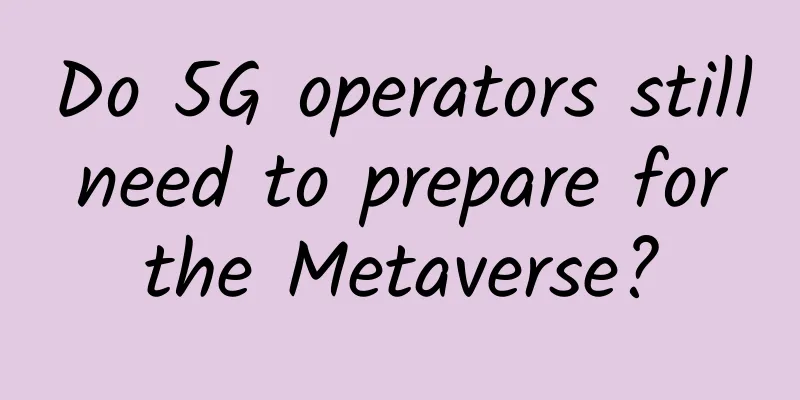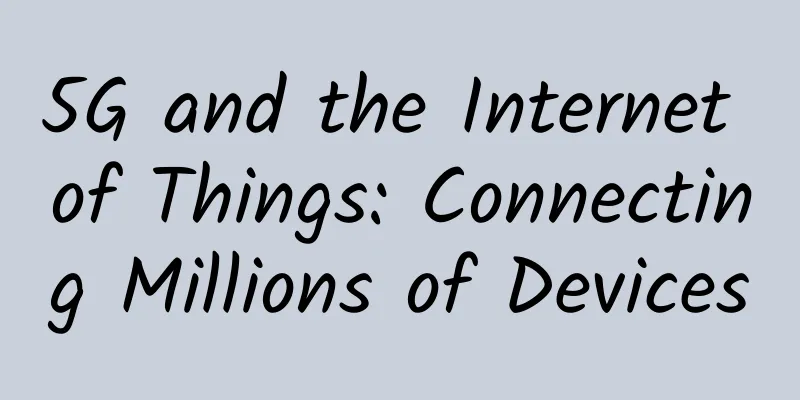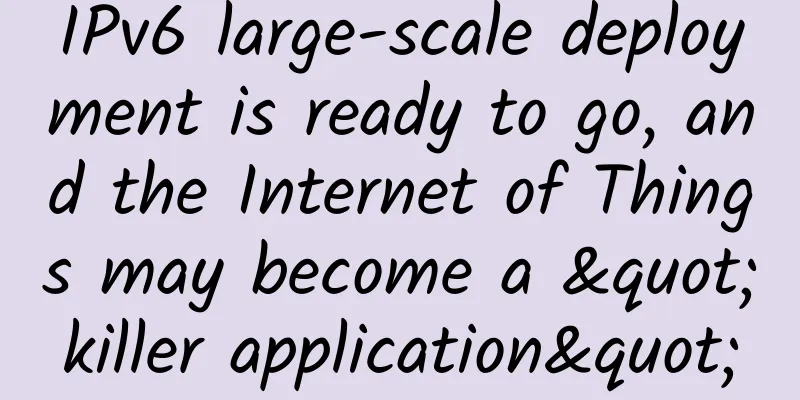Do 5G operators still need to prepare for the Metaverse?

|
The 2022 Mobile World Congress (MWC2022) held this week has come to an end. As a top event in the ICT field, although the number of participants was less than before the epidemic due to the impact of the new crown epidemic, its role in leading the direction of the industry has not diminished. As a hot concept in 2021, the Metaverse has also become an important theme of this year's MWC conference. However, this conference is not to showcase the achievements of the Metaverse, but to put forward requirements for the ICT industry to support the Metaverse, especially the challenge of meeting the needs of the Metaverse for the current most popular 5G connection. The main driving force is still Meta, which was renamed from Facebook. Meta executives challenge the communications industry to build a Metaverse-ready networkOn the eve of the opening of MWC2022, Dan Rabinovitsj, head of Meta's connectivity business, published an article titled "The Next Big Connectivity Challenge: Building a Metaverse-Ready Network", pointing out that the current communication network is not sufficient to support the large-scale application of the Metaverse, and that a fundamental change is needed in the way the network is built and deployed. At the same time, Meta also joined hands with Telefonica to hold a seminar called "Enabling Metaverse-ready Networks" during MWC2022, and invited experts from mainstream manufacturers such as Microsoft and Vodafone to discuss the topic of supporting Metaverse network technology. As 5G has become the mainstream network standard for commercial use in the global mobile communications industry, Meta and other promoters of the Metaverse have challenged the communication networks that support the Metaverse. It can be seen that the current 5G is not only far from supporting the vision constructed by the Metaverse, but also cannot effectively support many foreseeable scenarios. Rabinovitsj mentioned in his article that the Metaverse is an unprecedented opportunity for the field of communication and connectivity, but it must be built on the basis of openness and interoperability. To make the Metaverse a reality, significant progress needs to be made in network latency, symmetric bandwidth, and overall network speed. At the same time, Meta also believes that no company or industry can do this alone, and creating Metaverse communication capabilities requires global efforts. For Meta, what kind of communication technology does the Metaverse need? Rabinovitsj proposed that the Metaverse will allow participants in different geographical locations to enjoy realistic spatial perception experiences that seamlessly integrate virtual content into the user's physical world and enable users to feel closer to each other. To achieve such an experience, innovations are needed in areas such as local and remote real-time rendering, video compression, edge computing, cross-level visibility, and radio spectrum, and requirements for cellular networks to be committed to future connection standards, network optimization, and latency improvements between devices and wireless access networks. Judging from some current products, the challenges of the Metaverse to the network mainly include: (1) Reduce latencyIn order to get a truly "immersive" experience, it is very important that the graphic elements of the immersive mixed reality world update quickly to respond to the way people interact with them. Today, 5G's low-latency sensitive applications, such as video calls and cloud games, must meet a round-trip time delay of 75-150 milliseconds, and in the case of multiplayer complex games, it even needs to be reduced to less than 30 milliseconds. But on a head-mounted mixed reality display, a delay of less than 10 milliseconds may be required. Although local real-time rendering can meet such strict latency constraints, local rendering requires pre-downloading of virtual worlds, characters, and scenes. For complex scenes with many avatars, downloading through the current network may take several hours. In the future, remote rendering on the edge cloud or a mix of local and remote rendering will be the mainstream approach, which requires rebuilding fixed and mobile networks, or even revolutionary improvements to the network. (2) Symmetrical bandwidthAnother direction of the Metaverse that Meta is calling on the communications industry to support is symmetric bandwidth. If users can’t quickly upload their own content while downloading everyone else’s, it won’t be an immersive experience. As we all know, previous mobile communication network technologies were designed to improve downlink rates. 5G, which is aimed at a large number of industry applications, has clear requirements for uplink. However, the downlink rate of the current commercial 5G network is still much higher than the uplink rate. In the process of 5G standard and technology evolution, uplink enhancement is a key research topic, which improves the uplink rate through flexible time slot allocation, uplink carrier aggregation, multi-frequency coordinated networking and other methods. (3) Common frameworkRabinovitsj also proposed the "common framework" that the Metaverse requires to support data sharing. As an example, he proposed that "in today's networks, protocols and algorithms running at the application layer (such as the adaptive bitrate control loop for streaming video) have no access to metrics about link quality and congestion from the physical layer. Similarly, protocols for optimizing traffic congestion mostly run independently of each other, with some handled by content providers and some by network operators. Therefore, Meta believes that there is an opportunity to achieve significant gains by moving beyond such isolated optimizations and moving to open interfaces to share metrics between OSI layers and network domains. The "common framework" proposed by Rabinovitsj actually contains the idea of mobile network operators sharing their core network interfaces. Although this proposal is attractive, it is a huge challenge for operators, which is more difficult than reducing latency and symmetrical bandwidth. The mobile communications industry has been studying this for more than ten years, but in fact there is no result. Rabinovitsj also proposed that it is hoped that a common framework can be defined to measure and evaluate the readiness of different levels of Metaverse use cases. For example, in order to unify the industry definition of high-performance end-to-end networks, it is necessary to develop common experience quality indicators and their role in evaluating network functions, and to correlate the relationship between network service quality indicators and user experience quality indicators. Different attitudes: Will operators be "bitten back" by the Metaverse?Undoubtedly, in order to realize the vision of the Metaverse, Meta has spared no effort in promoting communication technology to support the Metaverse. Many years ago, Meta invested billions of dollars in communication technology, such as the Free Basics free Internet plan, the Terragraph project, the Telecom Infra project, and the High-altitude Connectivity project. Among them, the Telecom Infra Project (TIP) is very familiar to the communications industry. The project was initiated by Facebook and several operators in 2016. It aims to define a complete set of open hardware platforms and software interface protocols through open source white boxes, break the monopoly of proprietary equipment in the communications industry, and provide network infrastructure services to operators based on standard hardware and software interface protocols. The seminar on Metaverse at this MWC conference was also promoted by TIP. At the same time, Meta announced a partnership with Telefonica to establish a Metaverse Innovation Center in Madrid to help accelerate the preparation of Metaverse networks and devices through trials, Metaverse-style use cases and device testing. Through this Metaverse Innovation Center, Telefonica and Meta plan to provide 5G labs for local startups and developers, who will be able to test end-to-end Metaverse applications on lab network infrastructure and devices. However, what do mainstream communications industry manufacturers think about this? Overseas media LightReading interviewed a number of global operators and published an article titled "The next worry for telecom companies is to pay for the Metaverse", listing the operators' helplessness in this regard. Global operators including Verizon, AT&T, Orange, and BT have proposed high investments in 5G, but the ultimate beneficiaries are companies like Meta, which have promoted the emergence of a large number of scenarios in the metaverse and gained huge economic benefits from these scenarios. However, these scenarios pose challenges to communication networks, and operators have to spend huge amounts of money to purchase more radio spectrum, build and upgrade network infrastructure, but the benefits are meager. It is undeniable that the demand for communication networks from the Metaverse proposed by Meta executives will bring about a sharp increase in network traffic and require operators to invest huge amounts of money. Operators may fall into the dilemma of "increasing volume but not revenue" and be "bitten back" by the Metaverse. For many years, many mainstream telecom operators have been calling on Internet companies to bear part of the cost of network construction. Last month, the CEOs of four European operators, Deutsche Telekom, Orange, Telefonica and Vodafone, issued a joint statement saying that the current situation is unsustainable and called for legislation at the EU level to force large technology companies, OTTs and other enterprises to pay their fair share of network investment. Citing data from Sandvine's Global Internet Phenomenon Report released in January 2022, videos, games and social media generated by a few digital content platforms account for more than 70% of all traffic on the Internet, and the trend continues to rise. At present, the main drivers of the Metaverse are also large technology companies such as video, games and social media. It is not difficult to imagine that in a few years, as some scenarios of the Metaverse are continuously launched, network traffic will also be focused on the applications of the Metaverse, and the network capacity and quality will be required to continue to improve, which will put tremendous pressure on operators' network investment. Of course, when Internet companies will not pay for network construction, operators will not sit idly by and will also conduct multi-faceted explorations to get rid of the function of pure pipelines. For example, South Korean operator SKT has previously taken the lead in launching the Metaverse service Ifland platform. During this MWC conference, SKT announced that it would open the platform to allow customers to generate content and will soon launch a blockchain-supported virtual market. Its goal is to launch its Ifland Metaverse service in 80 countries this year, in order to become a global leader in the next generation of key technologies. China Mobile proposed to make every effort to build a new information service system of "connection + computing power + capability" based on 5G + computing power network + smart middle platform. In the field of computing power, the resource interconnection, system penetration and integrated services of computing power and network should be basically realized within 2022. Recently, China Mobile has combined computing power network with the concept of Metaverse to create a variety of applications such as sports star digital intelligence, XR studio, and AR ice and snow town. However, operators still face enormous pressure from hundreds of billions of network investments each year. In the future, if the Metaverse develops along the expected path, will mobile communications become one of the biggest bottlenecks in its development? |
<<: Is 5G really green, or will it consume more resources?
>>: A brief history of computer networks
Recommend
Network equipment and protocols - equipment
Preface When answering questions about computer n...
You want to ask me about the application layer? I'll just talk to you about it.
Network applications are the reason for the exist...
RackNerd latest promotion starts at $11.38/year, San Jose/Seattle and other data centers
RackNerd has launched a new promotion for the US ...
Development status of private network communication: broadband and narrowband integration becomes a consensus, and equipment vendors are "shuffling"
A year ago, a netizen posted a series of articles...
A national expert group visited Tiantan Hospital to discuss the smart transformation of hospitals in the digital era
On August 27, the "Entering Tiantan - Smart ...
Watching B station can be faster!
[[384367]] This article is reprinted from the WeC...
The United States has another big move for 5G: agreeing to merge two major operators
The Trump administration has tried every possible...
Let's take a look at what new tricks Huawei has come up with during its ICT Ecosystem Tour in China!
[51CTO.com original article] At the Huawei China ...
Huawei's Yang Xiaoning: Building a secure digital society through openness, collaboration, and development
[The Hague, Netherlands, May 29, 2019] The Mobile...
VULTR: KVM in 17 data centers in Japan, South Korea, Singapore, etc. Monthly payment starts from 3.5 USD, supports hourly billing, and registration will give you 100 USD
VULTR is a foreign VPS merchant founded in 2014. ...
What are the advantages of using wireless mesh networks in enterprises?
In the traditional wireless network usage environ...
The ultimate competition, the battle of the strong--Kunpeng Application Innovation Competition 2020. The Zhejiang Division Finals was successfully held
[51CTO.com original article] On August 21, the fi...
80VPS: KVM in Los Angeles MC data center is online, 1G memory package starts at 199 yuan per year
Some time ago, we shared the news that 80VPS laun...
The three major operators secretly cut 5G prices. Users: The private 9-yuan package is still more attractive
According to customer service, the 5G network tra...
5G news is coming! China Mobile has opened trial commercial services to 15 provinces: over 100 million users, no need to change to 5G phones
On October 14, at the "5G Message Ecosystem ...









